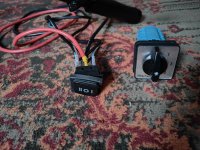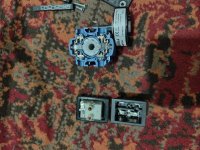nickceouk
10 W
- Joined
- Jan 18, 2020
- Messages
- 86
I want to know what is the best solution for switching battery input to an ebike controller (BR v5 z9 but this should not be important).
As far as I could find by searching there is Option 1 an automotive/marine switch rated as 15A 250V AC or 20A at 125V AC ( left side in photos).
It's a dual pole dual throw switch - DPDT.
Option 2 Cam switch (right side on photos) which is rated at 20A 440V (AC-15) and 240V, 1A (DC-13)
1)Batteries I want to switch are OEM 13s with max draw of 20amps (case sticker)
2)14s with 80amps = 1C
3)14s with 20amps = 1C
4) potentially another 13s with 20amps= 1C
If I go by the rating the Cam switch has higher AC rating but I am also stumped by the 1A DC rating.
by the 1A DC rating.
I also opened both to see which one has better(bigger) contacts inside the actual switch and upon inspection it's the automotive/marine switch which also looks much smaller overall compared to the Cam switch.
The batteries will feed the BR( set as 1000W ) through one switch that toggle internal OEM battery or external battery mounted under the seat post area and a second switch in a trailer will select which of the external batteries is used in the trailer.
I would use this setup for long trips ...so heating is an unknown and need help from more advanced users
As far as I could find by searching there is Option 1 an automotive/marine switch rated as 15A 250V AC or 20A at 125V AC ( left side in photos).
It's a dual pole dual throw switch - DPDT.
Option 2 Cam switch (right side on photos) which is rated at 20A 440V (AC-15) and 240V, 1A (DC-13)
1)Batteries I want to switch are OEM 13s with max draw of 20amps (case sticker)
2)14s with 80amps = 1C
3)14s with 20amps = 1C
4) potentially another 13s with 20amps= 1C
If I go by the rating the Cam switch has higher AC rating but I am also stumped
I also opened both to see which one has better(bigger) contacts inside the actual switch and upon inspection it's the automotive/marine switch which also looks much smaller overall compared to the Cam switch.
The batteries will feed the BR( set as 1000W ) through one switch that toggle internal OEM battery or external battery mounted under the seat post area and a second switch in a trailer will select which of the external batteries is used in the trailer.
I would use this setup for long trips ...so heating is an unknown and need help from more advanced users
Attachments
Last edited:



